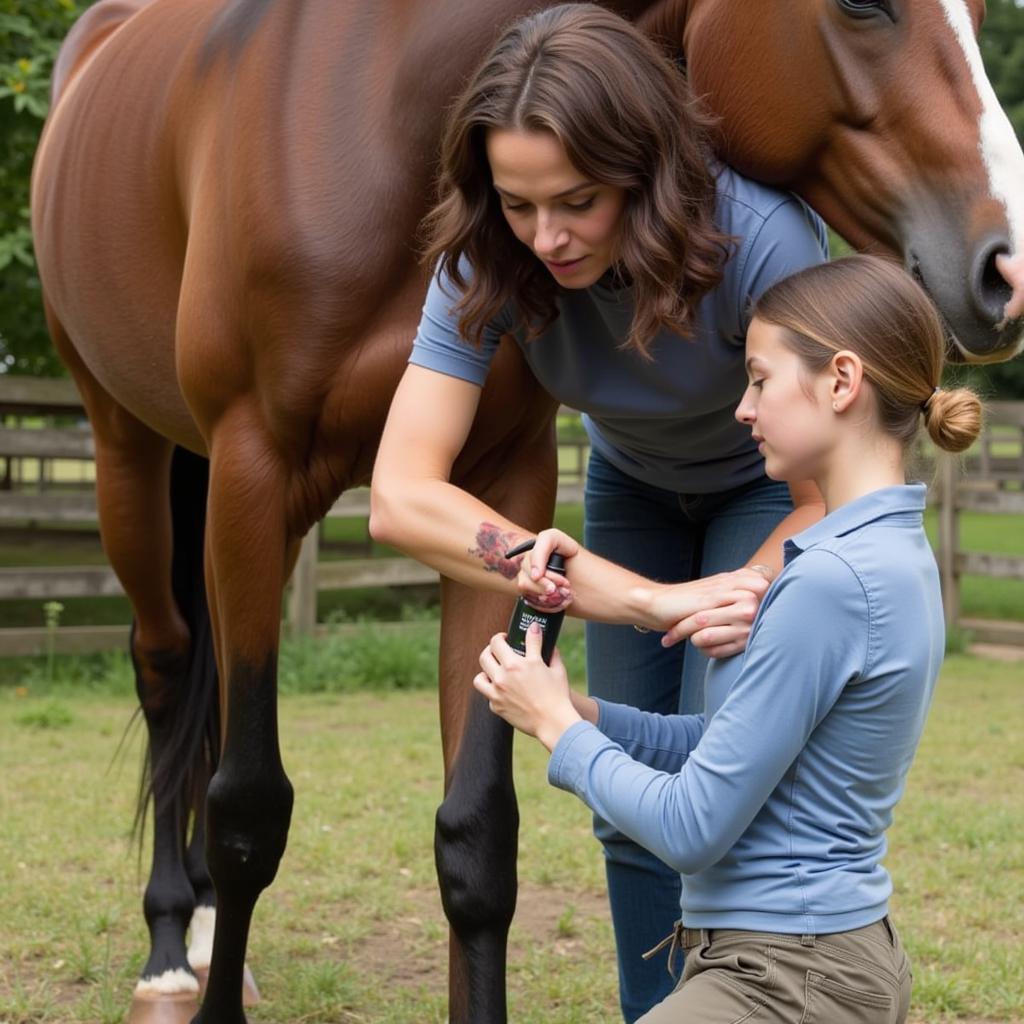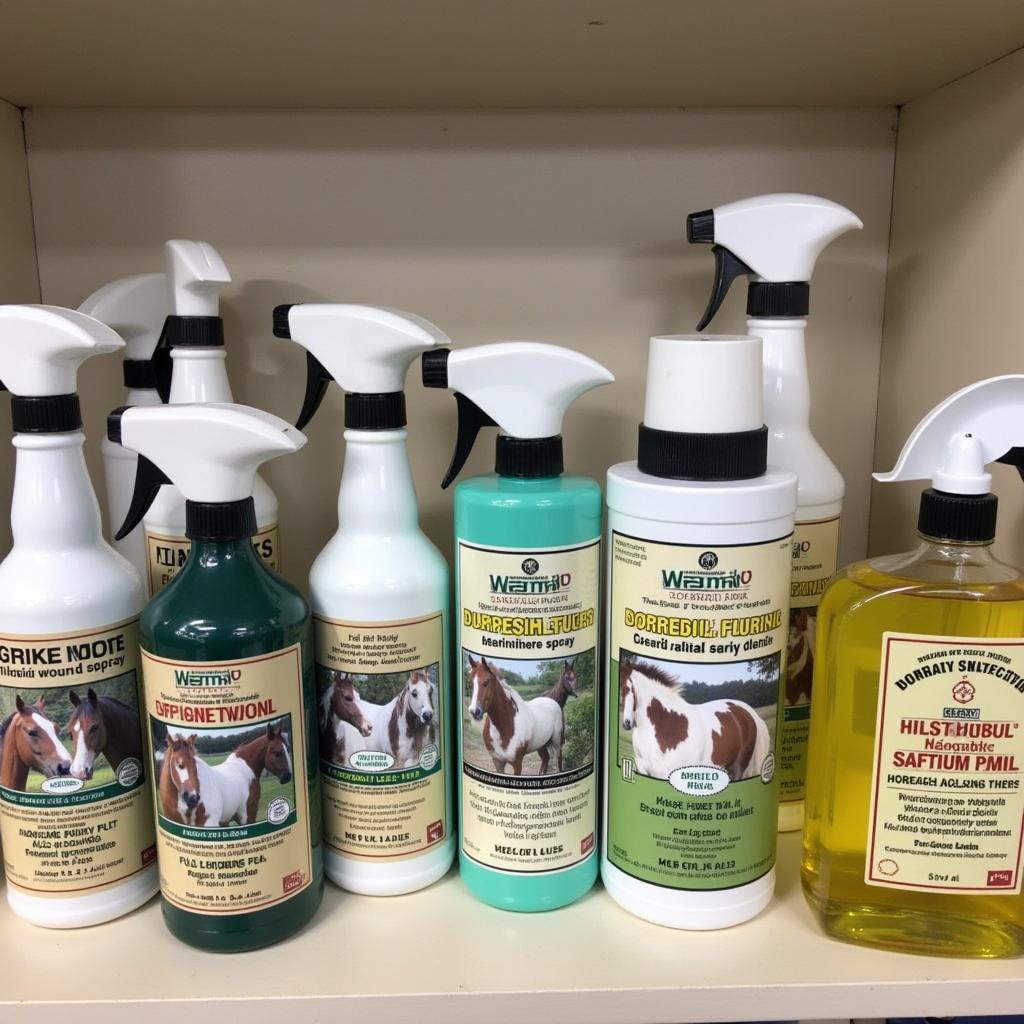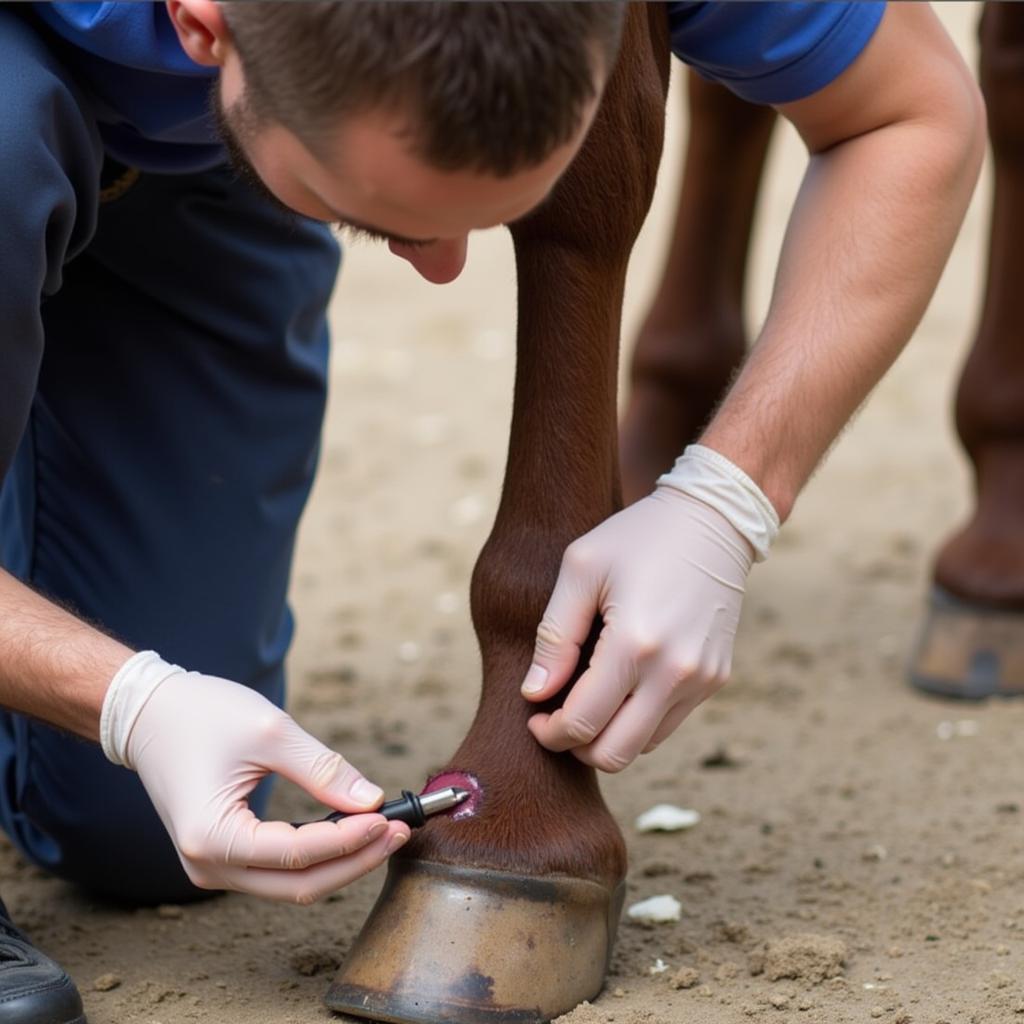When it comes to our equine companions, even a minor scrape can quickly escalate into a major concern if left untreated. That’s why having the right wound care products, particularly a reliable Spray For Horse Wounds, is crucial for any horse owner. Choosing the correct spray and understanding proper wound management techniques can significantly impact your horse’s healing process and overall well-being.
 Treating a Horse Leg Wound
Treating a Horse Leg Wound
Understanding Different Types of Horse Wound Sprays
Navigating the world of wound care for your horse can feel overwhelming with so many products available. It’s essential to understand that not all horse wound sprays are created equal. They come in various forms, each with its unique purpose and benefits:
- Antiseptics: These sprays are your first line of defense against infection. They work by killing bacteria and other microorganisms that can invade and complicate the wound. Common antiseptic ingredients include chlorhexidine and povidone-iodine.
- Cleansing Solutions: These sprays help flush out dirt, debris, and foreign objects from the wound, creating a clean environment for healing. Saline solutions are a gentle and effective option.
- Healing Promoters: Designed to encourage the body’s natural healing process, these sprays may contain ingredients like aloe vera, honey, or silver, known for their soothing and tissue-regenerating properties.
- Fly Repellents: Flies are notorious for being attracted to wounds, potentially causing further irritation and infection. Sprays with fly repellent properties often contain pyrethrins or permethrins to deter these pesky insects.
 Horse Wound Sprays on a Shelf
Horse Wound Sprays on a Shelf
Choosing the Right Spray for Your Horse’s Wound
Selecting the appropriate spray for horse wounds requires careful consideration of several factors:
- Type of Wound: Is it a puncture wound, a cut, an abrasion, or a burn? Different wounds require different approaches to treatment.
- Severity: A superficial scrape will need a different spray than a deep puncture wound.
- Location: Wounds in certain areas, like joints, may require specific types of sprays to accommodate movement and flexibility.
- Stage of Healing: The needs of a fresh wound differ from those of a wound in the later stages of healing.
Always consult your veterinarian to determine the most appropriate spray for your horse’s specific needs.
Applying Spray for Horse Wounds: A Step-by-Step Guide
Administering wound spray correctly is crucial for effectiveness and your horse’s comfort. Here’s a general guide:
- Safety First: Approach your horse calmly and confidently. If your horse is nervous, have a helper hold them securely.
- Cleanse the Wound: Before applying any spray, gently clean the wound with a marigold spray for horses or saline solution to remove dirt and debris.
- Shake Well: Ensure the spray is well-mixed by shaking it thoroughly before each use.
- Maintain Distance: Hold the spray bottle 6-12 inches away from the wound and apply an even layer. Avoid touching the nozzle to the wound.
- Observe for Reactions: After application, monitor your horse for any signs of discomfort, irritation, or allergic reactions. If any adverse effects occur, discontinue use and contact your veterinarian.
Preventing Horse Wounds: Proactive Measures for a Safer Environment
While it’s impossible to entirely eliminate the risk of wounds, proactive measures can significantly reduce their occurrence. Consider these tips:
- Regular Pasture Checks: Inspect your pastures regularly for potential hazards like protruding nails, broken fences, or sharp objects.
- Safe Fencing: Opt for safe fencing materials like vinyl or flexible rails that are less likely to cause injury.
- Proper Stall Maintenance: Ensure stalls are free from protruding objects and have adequate bedding to cushion falls.
- Careful Handling: Use appropriate training techniques and handling practices to minimize the risk of accidents during grooming, riding, or other activities.
When to Consult a Veterinarian
While minor wounds can often be managed with basic first-aid and over-the-counter sprays, certain situations warrant immediate veterinary attention:
- Deep Wounds: If the wound is deep, heavily bleeding, or exposes tendons or bone, call your veterinarian immediately.
- Signs of Infection: Look for signs of infection like redness, swelling, heat, pus, or a foul odor.
- Puncture Wounds: Puncture wounds are particularly susceptible to infection and often require professional cleaning and antibiotics.
- Wounds That Don’t Heal: If a wound isn’t showing signs of improvement within a few days or worsens, consult your veterinarian.
 Veterinarian Examining a Horse Wound
Veterinarian Examining a Horse Wound
Conclusion
A well-stocked first-aid kit with a quality spray for horse wounds is essential for any horse owner. Understanding the different types of sprays, how to choose the right one, and how to apply it correctly can make a significant difference in your horse’s well-being. Remember, prompt and appropriate wound care, along with proactive prevention strategies, is crucial for ensuring your equine partner’s health and happiness.
For a wide selection of horse and barn supplies, including various cream for horses and grooming tools for horses, visit Justus Horses USA. We offer a comprehensive range of products to support your horse’s health and help you provide the best possible care.
Need more specific wound care solutions? Explore our selection of swat ointment for horses to address various skin irritations and conditions.
Need help choosing the right spray for your horse’s wound? Don’t hesitate to contact us. At Justus Horses USA, we are committed to providing you with the information and resources you need to be a responsible and informed horse owner. Call us at 0772127271, email us at [email protected], or visit us at QGM2+WX2, Vị Trung, Vị Thuỷ, Hậu Giang, Việt Nam. Our dedicated customer support team is available 24/7 to assist you.